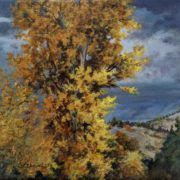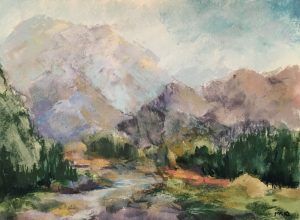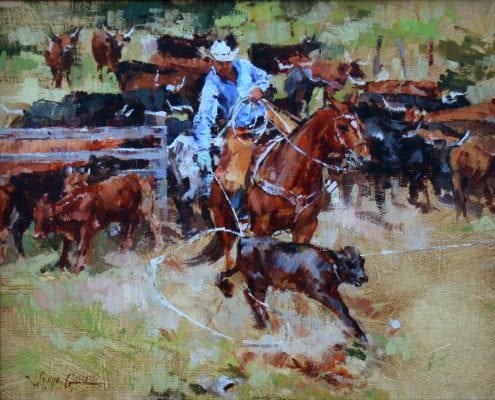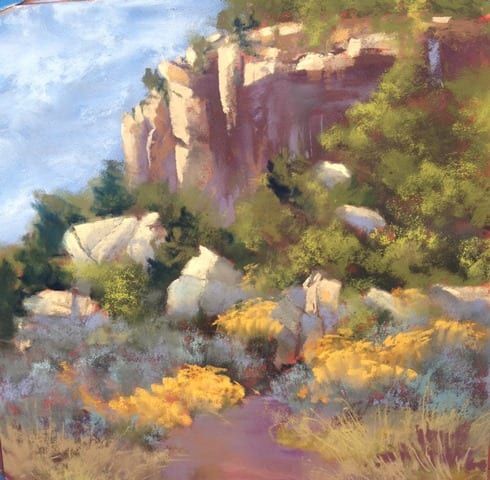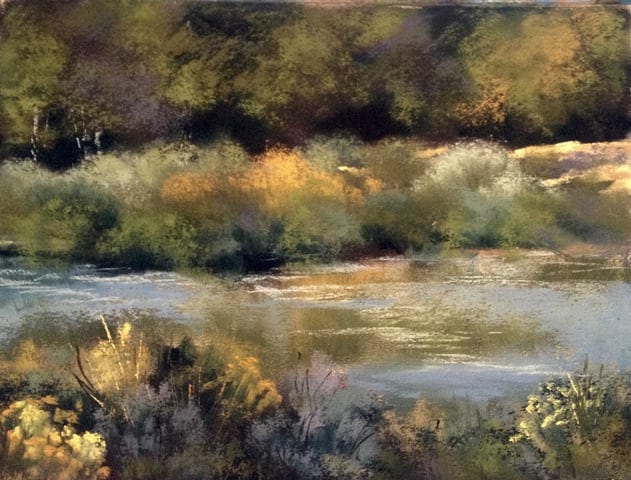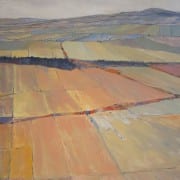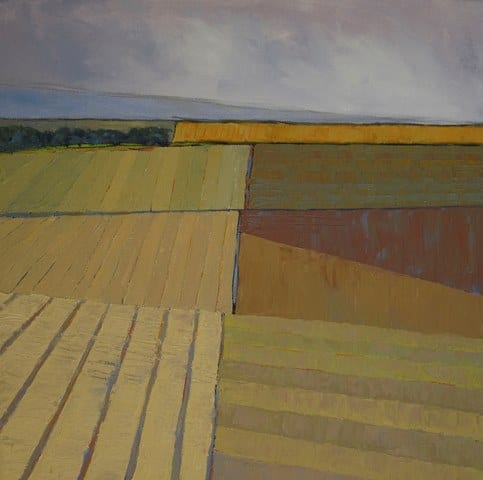Improvising and Adapting — the Paintings of Joan Eckman

As any plein air painter knows, sudden changes in weather are an improvising factor that keep us from being static. Weather Moving In, original acrylic painting by Joan Eckman.
You’re taking a journey. You’ve packed your bags, and in short time, get to your destination. And then you discover that you forgot your toothbrush.
While it’s not a disaster, it is an inconvenience, and how far you are from a -Mart store determines how creative you get about improvising.
For Joan Eckman, an acrylic painter from Yakima, the destination was out in the boonies. And the brush, quite unfortunately, wasn’t just a toothbrush. But Eckman wasn’t about to let a major inconvenience become an overwhelming obstacle:
“I was on a plein air painting outing, and I had forgotten my brushes.
“So I wrapped a piece of paper towel around a pencil and painted with that along with a twig to make scratches and some detail lines. It turned out very loose and impressionistic.

It’s a quiet moment in the wilderness, far from the noise of the city. Sun on the Little Naches, original acrylic painting by Joan Eckman.
“And though it was nothing to brag about, I kept it as a reminder of what can be done, and because I actually like the spontaneity of it.”
Adapting to Change
Improvising, adapting, being willing to change are characteristic of Eckman. An avid enthusiast of the outdoors, Eckman found herself forced into temporary inactivity after a skydiving accident when she was 22 left her partially paralyzed. Rather than rail against fate, she turned fervently to art, focusing on detailed pencil renderings and watercolor paintings. This latter medium was easy for her to take on what she calls her meanderings, which she accomplishes with the aid of crutches and braces.
“I keep a backpack of art supplies for plein air outings,” Eckman explains. “Everything in it is small and lightweight, keeping the pack under 20 pounds for mobility.”

Eckman was far away from a store when she found she had forgotten her brushes on a plein air outing. Improvising was the only solution. Canyon Morning, original acrylic painting by Joan Eckman.
Eckman, who uses a spare bedroom as her studio, has now moved on to acrylics, which she turned to when she became frustrated with not getting the detail and texture that she wanted with watercolor.
“However, there were many attributes that I loved about watercolor, so I chose acrylics as a medium that I could utilize in both those applications. I can get transparent glazes and texture. I’m still learning, and what a fun process it is.”
Right Brain, Left Brain Improvising
Like many artists, Eckman had to put full-time painting on hold while she and her husband raised their family and she pursued her career as the city clerk-treasurer of Connell, WA. Upon her retirement after 25 years with the town of Connell, Eckman and her husband resettled in the Yakima Valley, when she pulled art out of the backseat of the car and plunked it firmly in the front behind the steering wheel.
“My work as a city clerk/treasurer required such high left brain usage! It’s nice to pursue right brain activities to balance things out.
“I enjoyed my job, and now I have opportunity to pursue my art. Life is good.”

Calmness and stillness reign in a peaceful moment on the pond. Mallards and Lilies, original acrylic painting by Joan Eckman.
Eckman regularly presents her work at various shows in the area, including the Larson Gallery Guild Members Show, the Annual Central Washington Artists Exhibit juried show, and the Oak Hollow Gallery Holiday Show, all in Yakima. She has also exhibited at Gallery One (Ellensburg); the BOXX Gallery (Tieton); and the Plein Air Washington Artists online show. Her sold work resides in the homes of collectors in Oregon, Washington, Idaho, Canada, and Washington, D.C.
Prose, Poetry, and Art
An integral part of Eckman’s creative process involves the use of prose and poetry to help her visualize what she is trying to say with any one artwork.
“My inspiration may come from a song, or even just a word. It may be a beautiful scene outside or a combination of all. Sometimes the picture idea comes first, and sometimes the picture idea develops around some words in my head, which then becomes part of the whole.” She places the prose and poetry journal entries on a note that she attaches to the back of the artwork, and also adds the information to the image description on its website page.
It all integrates, it all matters, and each brush stroke — whether it’s from a sable brush in the studio or improvising a pencil wrapped with a paper towel — is one step further on the artist’s, and viewer’s, journey. Nature is a great teacher, Eckman believes, and there are many life lessons to learn if we take time to ponder and observe the world around us.
“Our world is beautifully created, and we should be diligent caretakers of that.
“Each moment is not its own, not a means within itself, or of itself. It’s a culmination of events leading up to and beyond that moment — as is life.
“There is so much beauty around us and life lessons to be learned.
“Hang on to the beauty.”
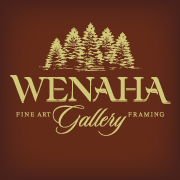 Joan Eckman is the featured Art Event at Wenaha Gallery from June 7 through July 4, 2022.
Joan Eckman is the featured Art Event at Wenaha Gallery from June 7 through July 4, 2022.
Contact the gallery, located at 219 East Main Street, Dayton, WA, by phone at 509.382.2124 or e-mail art@wenaha.com. Gallery hours are 9 a.m. to 5 p.m. from Monday through Friday, and by appointment. Visit the Wenaha Gallery website online at www.wenaha.com.

